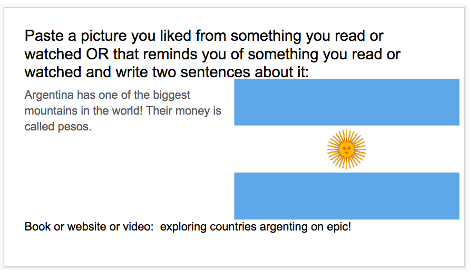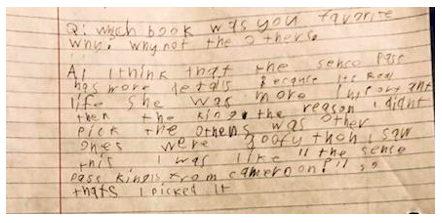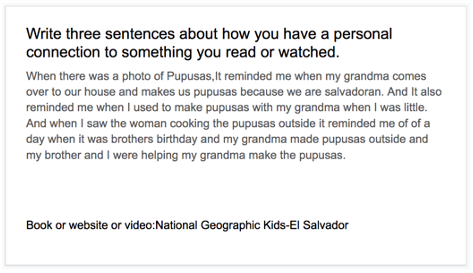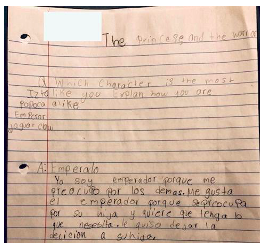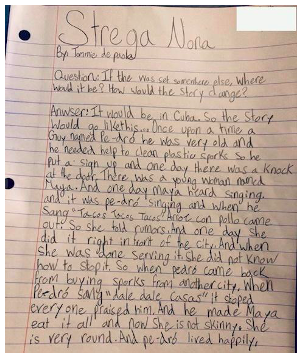Cosmopolitan Explorations of Culture Through an Intentionally Curated Text Set
J. M. Lopez
Cosmopolitanism embodies the idea of many people from different cultures existing in the same space who are open to learning about and celebrating each other’s unique perspectives, maintaining their individuality, but also embracing connections across cultures (Roudometof, 2005). Hull and Stornaiuolo (2014) suggest that the various cosmopolitan stances students take on include a proximal stance in which students develop an understanding of themselves, a reflexive stance in which students understand the differences between themselves and others, and a reciprocal stance in which they make connections with others across cultures. My goal as a teacher is to facilitate students adopting each of these stances through a cosmopolitan view of the world. One way to accomplish this is through their encounters with literature. Literature, as Rudine Sims Bishop (1990) has stated, can be a mirror, window, or sliding glass door. I want to validate students’ diverse experiences by exposing them to texts that show them reflections of themselves as well as experiences different from their own.
Working in a dual language classroom with students who are learning in both Spanish and English and who come from various language backgrounds, I have also sought to promote translanguaging through reading and responding to literature. Translanguaging involves the fluid use of language by bilinguals as they use their full linguistic repertoires to communicate (García & Lin, 2017). Students who are translanguaging may express their thinking in any combination of their languages within the same setting. This complements a cosmopolitan view in recognizing one’s languaging as a cultural element and promoting a celebration of multiple cultures through the use of multiple languages. Therefore, inviting students to see how they can be reflected in texts and to promote their interest and understanding of each other’s cultures, I chose to curate a text set based on their families’ cultural heritages. I was also intentional on how I elicited responses from students that honored their uses of language and promoted translanguaging.
I teach in a suburban school district in the southern United States. Our school district has adopted a two-way dual language model in which the students receive half of their instruction in English and half of their instruction in Spanish. Between the two groups of students enrolled in the third-grade dual language program, there are 37 students, 17 are native Spanish speakers, 18 are native English speakers, 2 are simultaneous bilinguals; 57% are Latinx, 35% are White, and 8% are Black.
Text Set Curation
To gather information about the students and their families, I created a home culture survey in English and in Spanish. In the survey, I asked the following questions:
- Do the members of your family (including parents, grandparents, as well as other extended family members) speak various languages? If so, what languages do the members of your family speak?/¿Hablan varios idiomas los miembros de su familia (incluyendo los padres, abuelos y otros miembros de la familia extendida)? ¿Qué idiomas hablan los miembros de su familia?
- Parents, where are the places you lived or regularly visited as a child?/Padres: ¿Dónde están los lugares donde viviste o visitaste cuando eras niño?
- Parents, where did your parents live when they were children?/Padres: ¿Dónde vivían tus padres cuando eran niños?
- How would you describe your family’s cultural heritage?/¿Cómo describirías el patrimonio cultural de tu familia?
- Are there any special ways that your family celebrates specific holidays?/¿Hay alguna forma especial en que su familia celebre días festivos específicos?
From the survey data, I identified various aspects of the students’ cultural heritage. I chose to draw from students’ cultural heritages in the creation of my text set because I thought they may be able to take on a proximal stance if they were able to see themselves reflected in the texts. They would also see the different cultures of their classmates reflected in the texts, giving them an opportunity to possibly take on reflexive and reciprocal stances as they would be able to see the differences between themselves and others and possibly make connections across their cultures. All of the categories included in the cultural heritage surveys would be too much to include in one text set, so I started with a text set based on the countries represented in the students’ families.
In the curation of the text set based on the 13 countries identified as represented within our classroom, I sought to compile a multimodal text set composed of various types of texts, websites, and videos, in both English and Spanish whenever possible. For each country, I tried to include two websites that included text and other graphics, two videos, an e-book, and three books, one informational about the country, one biographical about someone from the country, and one fictional text either set in the country or about someone from the country, or the retelling of a myth or folktale from the country. The rationale behind including the various genres of texts was to include cultural values that may be more or less overt depending on the type of text. Some countries were harder to compile resources for than others, but I was able to find at least one video, book, and website for each one. I tried to pull resources from websites I had access to as a teacher that were either free or resources paid for by the school district. The videos came from Discovery Education or YouTube, and the websites I used were informational pages about the countries from National Geographic Kids and/or PebbleGo. The e-books were general informational texts about the countries that were assigned to students on the application Epic!. All of the physical books that were biographies, fictional stories, or myth/folktales were found in the school library.
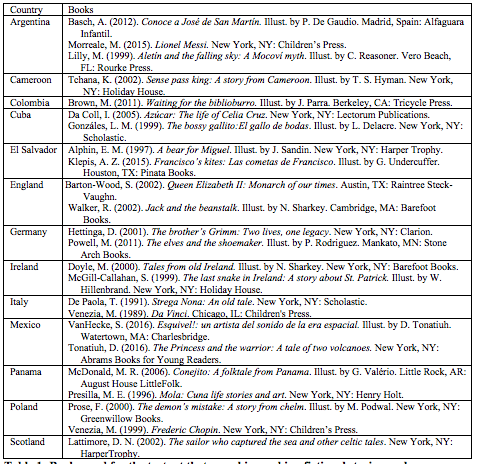
Figure 1: Books used for the text set that were biographies, fictional stories, and myths/folktales.
Reading Responses
I provided the students access to the texts for two weeks. Websites and videos were posted in Google Classroom, e-books were assigned to student accounts on the application Epic!, and physical books were on a bookshelf in the classroom. A written response was collected each week on Google Classroom. Students were allowed to respond to one text of their choice from the text set on Google Classroom by responding to one prompt from a menu of reader response prompts. The reader response menu items included the following prompts in English and Spanish so students could also have choice in their language of response:
- Paste a picture you liked from something you read or watched OR that reminds you of something you read or watched and write two sentences about it.
- Write three sentences about how you have a personal connection to something you read or watched.
- If you read a story, write a prediction for what you think might happen next at the end of the story. Write at least 3 sentences.
- If you read a nonfiction book, watched a video, or browsed a website, write your favorite fact that you learned and two sentences about why you liked it.
- Does what you read or watched make you think of another book, video, or webpage? Write about how it connects to something else. Write at least 3 sentences.
I also read one of the fiction books from the text set each week to the whole class. As a class, the students selected which text they wanted to hear read aloud by voting. After reading, students wrote a response to a prompt that was written on the board. Students were able to respond to the prompt in English, Spanish, or a combination of the languages. The prompts were as follows:
- If this story was set somewhere else, where would it be? How would that change the story?
- Which character was the most like you? Explain how you are alike.
- Which book was your favorite? Why? Why not the others?
Observations and Student Work Samples
As students were given class time to explore the various text sets, I noticed that they often first gravitated towards texts that represented their cultural heritage, many times selecting the informational websites on National Geographic Kids or PebbleGo to learn more about the countries that their families came from. I also noticed these influences in their written responses, both on Google Classroom and on paper. The texts read to the whole group were read in English, but the texts selected by the students could have been in English or Spanish. I saw the presence of the two languages in their written responses as they sometimes responded in Spanish or even infused Spanish words in various places throughout their mostly English responses. The following samples show the influences of students’ cultural heritages and the presence of translanguaging. Note that all student names have been changed to protect student confidentiality.
Cosmopolitan Views in Student Work
David’s mother is from Argentina, and the first text he chose to read was the National Geographic Kids website about Argentina. Throughout the week, he continued to read more about Argentina, by himself and with other students, and he decided to write about Argentina in his reading response. His excitement over seeing his cultural heritage represented in the texts about Argentina and then sharing these texts with other students with different cultural backgrounds shows how he took on the proximal stance of cosmopolitanism.
Hugo’s response reads:
-
- Q: Which book was your favorite? Why? Why not the others?
- A: I think that the Sense Pass has more details because it’s real life. She was more important than the king. The reason I didn’t pick the others was other ones were goofy. Then I saw this, I was like “The Sense Pass King is from Cameroon?” so that [why] I picked it.
Hugo’s family is from Cameroon and he was excited to see that the book was set in his family’s country of origin. I saw him read the text multiple times throughout the duration of this text set with other students in the class. His eagerness to share a book that represented his cultural heritage with other students in the class and their eagerness to learn about his cultural heritage show both his and the other students’ growing cosmopolitan views, moving into reflexive and reciprocal stances of cosmopolitanism as students explored their cultural differences and connections through the use of this text.
Translanguaging in Student Writing
Amaya’s family is from El Salvador and, while I noticed her reading about many different countries, she chose to write about the country that her family is from. As she read about El Salvador, she was reminded about her experiences with her grandmother. Even though she calls her grandmother “abuela”, I thought it was interesting that she chose to translate the word “abuela” to “grandma”, but she opted to keep the word “pupusa” in Spanish instead of trying to translate it into an English word. In this sample, she shows how she navigates between English and Spanish in ways that communicate her meaning.
Jose’s response reads:
-
- Q: Which character is the most like you? Explain how you are alike.
- A: Emperador. Yo soy emperador porque me preocupo por los demas. Me gusta el emperador porque se preocupa por su hija y quiere que tenga lo que necesita. Le quiso dejar la decision a su hija.
English translation:
- Emperor. I am the emperor because I worry about others. I like the emperor because he worries about his daughter and wants her to have what she needs. He wanted to leave the decision to his daughter.
The text was read in English and the prompt written on the whiteboard was also in English. Before writing, students were given the opportunity to discuss the prompt with a partner. After discussing it in English, José chose to write in Spanish. His ability to receive input in English through the reading of the text and the writing prompt and then to write his response in Spanish show how he processes language. He was able to navigate between the two languages to write a response in the language that allowed him to express his thoughts in the most meaningful way.
Like in the previous example, the text was read in English and the prompt written on the whiteboard was also in English. After discussing the text with a partner in English, Sofia chose to write her response mostly in English with some words and dialogue in Spanish. She writes about “Arroz con Pollo” [rice with chicken], a Cuban dish. She also writes, “‘dale dale casas” [give it, give it, houses]. Her grandparents are from Cuba and the influences of her Cuban cultural heritage and the Spanish language are present throughout her response. Her language choices in combining a mixture of English and Spanish allowed her to infuse the influences of her cultural heritage in her writing.
Drawing on Students’ Cultural Heritage and Linguistic Repertoires
As teachers, we often hear about the importance of getting to know the students we serve so that we can engage them by making learning relevant to the students as individuals. I was able to see how seeking input from students and their families helped me curate a text set that was engaging. The inclusion of students’ cultural heritages in the text set allowed students to see themselves and their peers reflected in the texts. While all of the written examples showed how students drew on their cultural and linguistic repertoires and easily took on a proximal stance, my observations of their interactions with texts and their peers showed how students took on reciprocal and reflexive stances as well. As students shared the texts with each other, these texts acted as the sliding glass doors through which they were able to enter each other’s worlds and learn more about each other’s cultural heritages (Sims Bishop, 1990).
Throughout the duration of the text set, students shifted from learning more about their own cultural heritages into sharing them with one another as time went on. This shifting point of view helped students develop a cosmopolitan view of culture in that they embraced their differences while also finding connections across their cultures (Hull & Stonaiulo, 2014). Giving them the freedom to express themselves in English or Spanish, while also providing texts in both languages, created an environment in which students felt safe enough to explore their linguistic expression, both verbally and in written formats (García & Lin, 2017). Valuing students’ cultural heritages and their linguistic expression elicited rich responses from them and to learn more about students and their families. Nurturing the home and school connection helps students be more successful, and, through this text set, students were excited to explore the texts and share what they had learned about themselves and about their peers with their families.
References
García, O., & Lin, A. M. (2017). Translanguaging in bilingual education. Bilingual and Multilingual Education, 117-130.
Hull, G. A., & Stornaiuolo, A. (2014). Cosmopolitan literacies, social networks, and “proper distance”: Striving to understand in a global world. Curriculum Inquiry, 44(1), 15-44.
Roudometof, V. (2005). Transnationalism, cosmopolitanism and glocalization. Current Sociology, 53(1), 113-135.
Sims Bishop, R. (1990). Mirrors, windows, and sliding glass doors. Perspectives, 1(3), ix–xi.
Jenna Lopez is currently completing a Ph.D. in Reading Education from Texas Woman’s University.
© 2021 by Jenna Lopez
WOW Stories, Volume IX, Issue 1 by Worlds of Words is licensed under a Creative Commons Attribution-NonCommercial-ShareAlike 4.0 International License.
Based on a work by Jenna Lopez at https://wowlit.org/on-line-publications/stories/volume-ix-issue-1/3/.
WOW stories: connections from the classroom
ISSN 2577-0551

